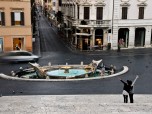The Basilica di Santa Maria Maggiore, or the Santa Maria Maggiore church, is located in Rome, Italy. The Italian word maggiore means major, and this signifies that the church is the most important one out of eighty Rome churches that are devoted to the Virgin Mary.
The church was made in the Roman tradition and has a large basilica that originally did not have a transept. A transept is a part of a church that is crosswise to the nave and creates a cross shape. It has a beautiful interior that has a magnificent gilded ceiling. Today, this important church is served by the Dominican fathers and is popular with tourists and pilgrims.
History
The church was built during Pope Sixtus III’s reign, during the years 432 to 440 AD. The bell tower was later added in the fourteenth century. It is 246 feet tall which makes it the tallest bell tower in Rome. It was built to guide pilgrims so they could find the church. Two chapels were added in the late sixteenth and early seventeenth centuries. It altered the overall layout of the church and made it similar to a Latin cross.
The Santa Maria Maggiore has gone through many changes over the centuries. The two-story arcade and facade was built in 1743. Pope Benedict XIV commissioned the designs. It covers the older twelfth century facade that had mosaics which were added in the last part of the thirteenth century. The Basilica di Santa Maria Maggiore was completely restored in the eighteenth century. The facade and the majority of the decorations inside the church date from this time.
Architectural Features
The original Santa Maria Maggiore’s architecture was traditionally Roman and very classical. The structure is immense and the basilica still has its early Christian style. It has a tall, broad nave that has side aisles and also a round apse. The main features that made the church stand out are the beautiful ancient mosaics on the nave.
The church is widely known for its impressive interior that still resembles an ancient basilica. The length of the church is 282 feet and it is separated into three naves. The oldest parts of the Santa Maria Maggiore are the Athenian marble columns that support the main nave. They may have originated from an ancient Roman building or were an original part of the basilica.
There are mosaics from the fifth century that can be seen underneath the windows and they depict many Old Testament scenes. The triumphal arch has golden mosaics that date back to the fifth century and display scenes from Christ’s early life. The capitals and bases had been rebuilt during the eighteenth century restoration. The church has an opus sectile mosaic that features a dragon and an eagle.
An additional focus of the church is the stunning coffered ceiling that was created in the sixteenth century. The gold that was used to decorate the ceiling is believed to have been brought back to Spain from the Americas by Christopher Columbus. It is believed that the King of Spain presented the gold to Pope Alexander VI.
Chapels
There are two chapels that are opposite each other, the Capella Sistina and Capella Borghese, which form the transept of the church. The Capella Sistina was named after Pope Sixtus V. The chapel contains the tomb of Pope Sixtus V. The tomb is embellished with reliefs and frescoes that depict important activities from his reign. This chapel was constructed in 1587.
The Capella Borghese, also called the Capella Paolina, and was built in 1611. Pope Paul V Borghese is buried in this chapel, along with Pope Clemens VIII and Pope Paul V. The Salus Populi Romani icon can be seen in this chapel, and is widely thought to be about one thousand years old.
Piazzas and Museum
There is a bronze Baroque figurine of Mary and child in the front square of the church. Pope Paul V had the statue erected in 1614. There is an obelisk that is situated at the Piazza dell’Esquilino, and it was erected by Pope Sixtus V in 1587. Originally, it was located at the Mausoleum of Augustus. There is staircase at the rear of the obelisk area that takes visitors to the apse and offers a wonderful view of the square.
There is museum underneath the church and it contains Roman remains which were found on the premises in the eighteenth century. These include two wells, a mosaic pavement, a part of an ancient Roman road, and some narrow passages that have been carved into the bedrock.





































